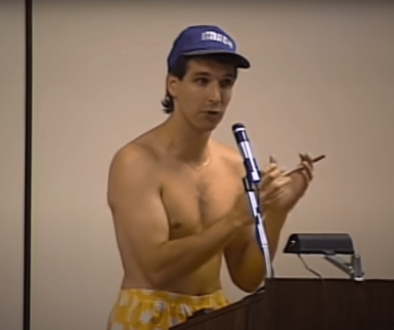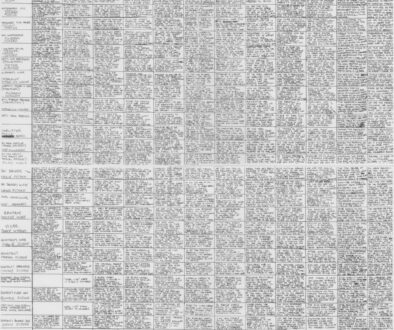Company Involvement (Book Three, Part 28: JFK, Milligan’s Animal Man)
Previously in The Last War in Albion: The first issue of Shade the Changing Man saw Kathy George attempt to witness the execution of her parents’ murderer, Troy Grenzer, only to have him end up on her back seat claiming to have been possessed by an alien entity, Shade.
“Funny thing, after JFK died in Dallas, lotta crackpots started claiming company involvement. They said a background bum in assassination photographs was Howard Hunt, disguised. They said Jack Ruby, who shot Kennedy’s assassin before he could stand trial, had mafia connections. So he had mob connections. These days, who don’t?” -Alan Moore, Brought to Light
Understandably dubious, Kathy takes Grenzer/Shade to a hotel room, and the story catches up with its beginning. In a development surprising only to people who didn’t read the name of the series, Kathy does not carry through with her plan to murder him, and instead she and Shade find themselves on a road trip tracking some mysterious entity from the Area of Madness known only as the American Scream. The particulars of what this evocative but far from self-explanatory setup became clear over the next two issues, which see Shade and Kathy pulled by the M-Vest into the orbit of a Kennedy conspiracy theorist whose obsessions the American Scream has latched onto and begun amplifying in strange and unexpected ways.

The Kennedy assassination is an event that puts the peculiarities of this era of the War in a strange and sharp relief. In 1990, when Milligan tackled the topic, the assassination was still less than thirty years ago—more recent than the comics themselves. And yet by the early 21st century the assassination of JFK would come to feel like strangely ancient history. Some of this, unquestionably, is due to the events of the early 21st century and the way in which September 11th, 2001 would supplant November 22nd, 1963 as a transformative date in American history ensnared by a web of conspiracy theories. But it also comes down to Kennedy himself. In 1990 he would have been an elderly man, but in no way too old to still be a prominent figure in American public life; then-President George H.W. Bush was only seven years younger than Kennedy would have been, and Reagan, out of office just three years, was six years older. His brother was still a US Senator. But in the decades that followed the living connections to JFK dwindled. Jackie Kennedy died in 1994, JFK Jr. In a fatal plane crash in 1999, Ted Kennedy a decade later. People who vividly remember the Kennedy assassination will stick around for a while yet, but already it’s become something that happened in people’s childhoods; in a few decades it will slip entirely from living memory.

In 1990, however, the assassination remained firmly relevant. Oliver Stone’s film JFK was a year away from theaters, while the books it was based on had come out the two years prior. In many ways, this was the height of the assassination’s pop culture relevance. The event was far enough in the past to no longer be a pressing issue, and so instead became known mostly as the site of a dizzying nexus of intersecting conspiracy theories, allowing it to exist as a metonym for conspiracy theories in general. These, it should be noted, were big business in the 90s, the decade that brought both popular culture icons like The X-Files and the rise of the conspiracy-minded Patriot movement.

All of this was aided by the actual events of the Kennedy assassination, which was almost perfectly poised to generate conspiracy theories. The official explanation—that Kennedy was shot by Lee Harvey Oswald, a troubled ex-marine—is unsatisfyingly small in its scale compared to the size of the action. The fact that Oswald was killed just a few days later by a strip club owner named Jack Ruby, meanwhile, ensured that questions like motive would never be decided and that there would never be the clean resolution of a trial. Meanwhile, anomalous details abounded. Oswald had previously made national news for an attempt to defect to the Soviet Union, while Jack Ruby had a variety of Mafia ties. Further excavation of the event quickly unearths possible connections to Cuba, the CIA, the military, possible second gunmen, and more—an endlessly unfolding fractal of details that stubbornly refuse to resolve into anything as singular as an explanation.

For Milligan’s part, when engaging with the Kennedy assassination he works through the sharp contrast of two approaches. On the one hand there is a forensic quality to the story, which opens with a splash page of a postmortem photograph of Kennedy’s fatal head wound with narration that offers a cold and clinical precision: “See for yourself. The fatal bullet hit him from the front. The large exit wound is on the back. Look. The parietal bone protrudes through the scalp, some of the skull’s occipital is fractured in its lateral half. The back of the head has opened up like a waterlily.” And the climax shows a Kennedy conspiracy theorist given a tour of the multiple concurrent truths of the assassination, tracing various prominent theories: the mob, the CIA, and the rest, exploring those explanations and how they overlap with each other. It’s detached, dispassionate, and firmly rational even as it makes its step into a mythic simultaneity of countless ghost assassins lining up to do the deed.

On the other hand, meanwhile, this is a story in which a giant stone head of Kennedy complete with bullet hole erupts out of the street in Dallas demanding to know “Who killed JFK” and eating anybody who gives an unsatisfying answer. Which is to say that it remains a comic firmly committed to the idea of madness. People have second faces burst out of their flesh, the aforementioned tour of the overlapping accounts of the assassination is conducted by the figure of the conspiracy theorist’s dead child, at one point the comic hypothesizes a psychedelic Kennedy who drops acid and gains enlightenment, and it ends with the title character becoming a two-dimensional cutout. It’s an extravagantly weird comic, and one that revels in this strangeness.
The contrast between these two approaches provides the main engine for the storyline. Milligan’s central contention is that the Kennedy assassination can only be truly understood from a perspective of madness—that a properly meticulous exploration of the facts necessarily required one to cross the line into explanations that did not strictly speaking make sense. Rationalism, applied diligently, led inexorably towards the irrational. This is not presented as some sort of classical horror story rooted in tension over the growing possibility of the supernatural. The lead character is an alien possessing the body of a serial killer via something called a madness vest; how could it? Instead it’s presented straightforwardly, as a clinical observation extending out from the bullet hole in Kennedy’s head. Madness is simply the only explanation that fits.

This sort of trick only works if the conclusion presented is compelling. Ultimately, however, Milligan’s is. The answer that finally appeases the Kennedy Sphinx is that “America killed him,” an answer earlier contextualized in an account of how Kennedy served as a God-King that America ritually consumed. “The mob and the CIA,” the comic explains, “are just the high priests, the guardians of America’s divinity… which is usually green and comes with a picture of Mr. Washington on one side.” It’s a tidy account, but one that undoubtedly makes more sense than any of the given conspiracy theories or the wild chain of of unlikely events that constitutes what, strictly speaking, actually happened.
Influences on this approach abound and are obvious; Milligan was surely drawing from Moore’s work on Brought to Light, and from From Hell, just as Morrison would a few months later for their own take on murder conspiracy in Bible John. But the influences undoubtedly run deeper than that. Much of the underlying logic—the clinical approach towards diagnosing American madness—has its roots in Ballard’s work, especially The Atrocity Exhibition, which ended with “The Assassination of John Fitzgerald Kennedy Considered as a Downhill Motor Race.” The larger take on conspiracy theories, meanwhile, owes as much to Milligan and Moore’s common influence in Robert Shea and Robert Anton Wilson’s The Illuminatus! Trilogy. But more than influence what comes through is simply the sense of Milligan as someone who is genuinely detached from America—an outsider peering through the glass and making sense of what he sees. It would be overstating the case to suggest that this makes him a more accurate chronicler of America’s psyche than an inside perspective, but it undoubtedly allowed him to find his way into spaces of that psyche that are not apparent from within.

The second issue of Shade the Changing Man coincided with the final issue of Morrison’s run on Animal Man, and the same day the Kennedy story resolved DC released Animal Man #27, which saw Peter Milligan take over the book for a six-issue run. In many ways the logic employed here was the same as had been used three years earlier to navigate Moore’s departure from Swamp Thing, in which the book and its new spinoff Hellblazer were handed off to writers within Moore’s basic aesthetic orbit. Likewise, the decision to follow their groundbreaking run with a writer who Morrison was close with—Milligan was one of Morrison’s early companions in exploring psychedelic drugs in the 1990s—Morrison describes the time that Milligan “travelled 400 miles to Glasgow for a dynamic, outrageous, drug-fueled plotting session” for their never-realized collaboration Bizarre Boys that they aimed to make “the strangest, most deranged 24 hours of our lives. Instead we spent the entire day and night zoned out in front of afternoon, then evening, then nighttime television, unable to produce a single interesting thought between us.”
Even in this early, cold war phase in which even the main combatants were yet to realize the scope of conflict which they were involved in there were the beginnings of a factionalization—on one side the writers like Gaiman, Ennis, and Delano who bore Moore’s express approval, on the other the coterie Morrison described as their “own gang of friends—Steve Yeowell, Mark Millar, John Smith, Chris Weston, Rian Hughes, Peter Milligan, Jamie Hewlett, Philip Bond, Simon Bisley.” The lines here were far from absolute, to be sure—Gaiman, in what hindsight makes one of the oddest pairings of the War, wrote the introduction for the trade paperback of the first five issues of Mark Millar’s Saviour, praising its mix of “social satire and social comment, horror and heartbreak, people and devils and angels and hookers and churches.” But it is striking, over the course of the decades, just how few collaborations exist between anyone on Morrison’s list and anyone broadly affiliated with Moore.

Milligan approached Animal Man with an impish determination to subvert the expectations Morrison had set up. His first issue sees Buddy becoming overcome by animal instincts—urinating on the street because “I’m home now and, you know, I thought I’d just mark out my homebase a little” and, in the issue’s cliffhanger, attacking and biting into horse at an animal rights protest. (“The crowd has stopped cheering,” Milligan’s narration dryly notes.) Sure, Morrison had Morrison suggest his successor might “do the obvious and go for shock by turning you into a meat-eater,” but it’s probably safe to say they hadn’t quite imagined this.

While the run started with an inventive bang, however, it quickly unraveled into the same sort of unruly excess that characterized Skreemer. Milligan piled ideas on top of ideas a superhero named Nowhere Man who spoke in Burroughs-style cutups, the Many Worlds interpretation of quantum mechanics, conspiracies to assassinate the President, and a trio of psychic children owing no small debt to Katsuhiro Otomo’s Akira (then in the midst of a US reprint from Marvel), and more. Morrison’s run was at times oblique—the particulars of John Hightower, Buddy’s psychedelic vision, and exactly what was going on with Psycho Pirate were easy to lose track of. But this was nothing in comparison to Milligan, whose story seemed to endlessly spiral outwards, adding more and more ideas without making wholly satisfying use of any of them.
It is not that the comparison to Morrison is unclear; Milligan is tangibly working in the same counterculture-inspired, surrealist vein as his friend and predecessor on the book. But in the end the same problems that made Rick Veitch’s Swamp Thing and Jamie Delano’s Hellblazer slightly pale imitations of the work they were following from apply. Milligan’s work on Animal Man could only ever be second best—an attempt notable for the fact that it was able to capture some of Morrison’s lightning in its bottle, but ultimately limited by the exact same thing. [continued]





October 31, 2021 @ 4:23 pm
Sides in the War: okay, that’s interesting.
Milligan’s Animal Man: I bailed after an issue or two, back when. It was pretty obviously influenced by Morrison’s contemporary Doom Patrol work, but… yeah, very similar to the post-Moore Swamp Thing: the words but not the music. Morrison has sometimes veered into weird-for-weirdness’-sake, but he almost always ends up connecting it to something — plot, or character. Milligan, not so much.
Anyway, a question. Will we get a discussion of Karen Berger at some point? (Or did it happen already, and I missed it?) She’s obviously a key figure in the War, but one that doesn’t get mentioned much these days.
Doug M.